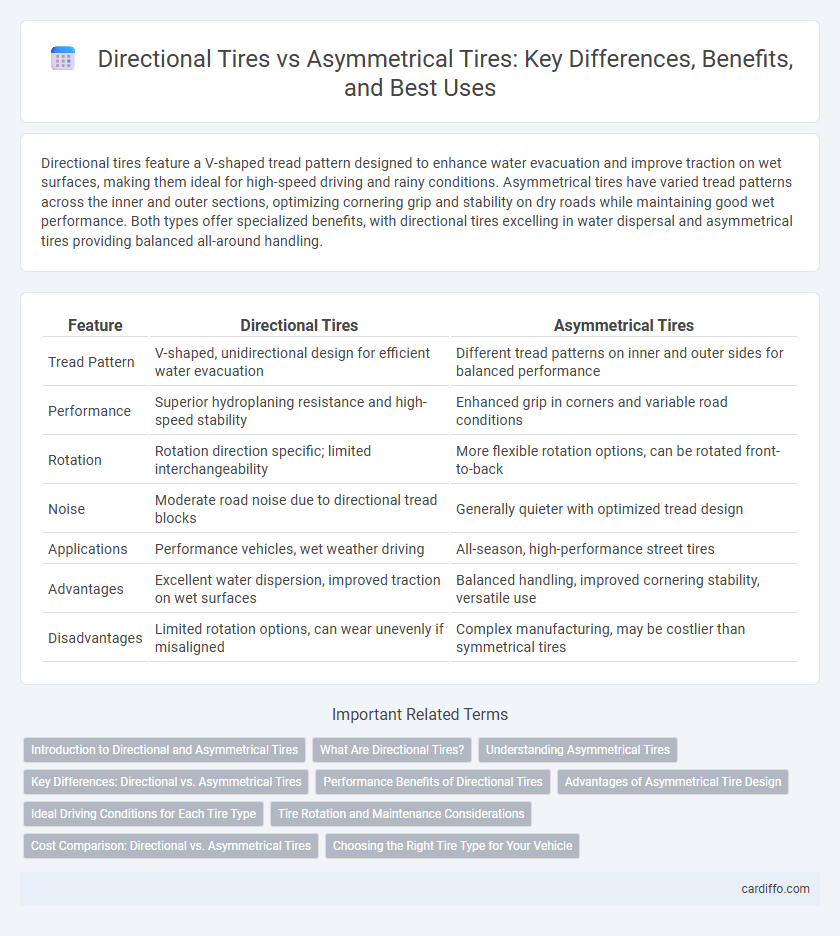Directional tires feature a V-shaped tread pattern designed to enhance water evacuation and improve traction on wet surfaces, making them ideal for high-speed driving and rainy conditions. Asymmetrical tires have varied tread patterns across the inner and outer sections, optimizing cornering grip and stability on dry roads while maintaining good wet performance. Both types offer specialized benefits, with directional tires excelling in water dispersal and asymmetrical tires providing balanced all-around handling.
Table of Comparison
| Feature | Directional Tires | Asymmetrical Tires |
|---|---|---|
| Tread Pattern | V-shaped, unidirectional design for efficient water evacuation | Different tread patterns on inner and outer sides for balanced performance |
| Performance | Superior hydroplaning resistance and high-speed stability | Enhanced grip in corners and variable road conditions |
| Rotation | Rotation direction specific; limited interchangeability | More flexible rotation options, can be rotated front-to-back |
| Noise | Moderate road noise due to directional tread blocks | Generally quieter with optimized tread design |
| Applications | Performance vehicles, wet weather driving | All-season, high-performance street tires |
| Advantages | Excellent water dispersion, improved traction on wet surfaces | Balanced handling, improved cornering stability, versatile use |
| Disadvantages | Limited rotation options, can wear unevenly if misaligned | Complex manufacturing, may be costlier than symmetrical tires |
Introduction to Directional and Asymmetrical Tires
Directional tires feature a V-shaped tread pattern designed to channel water away, enhancing wet traction and reducing hydroplaning risks, making them ideal for high-performance driving in rainy conditions. Asymmetrical tires combine different inner and outer tread designs, optimizing grip, handling, and tread life by balancing wet and dry performance while providing improved cornering stability. Both tire types are engineered to enhance vehicle safety and performance, with directional tires offering focused water dispersion and asymmetrical tires delivering versatile all-around traction.
What Are Directional Tires?
Directional tires feature a tread pattern designed to rotate in one direction, enhancing water evacuation and improving traction on wet surfaces. Their V-shaped grooves optimize hydroplaning resistance and provide superior handling in rainy conditions. These tires are ideal for high-performance vehicles that require precise steering response and enhanced wet-weather grip.
Understanding Asymmetrical Tires
Asymmetrical tires feature varied tread patterns on different sections of the tire to optimize performance for both wet and dry conditions, enhancing cornering stability and reducing road noise. Their inner tread typically focuses on water dispersion to improve wet traction, while the outer tread emphasizes rigidity for better handling and grip during turns. This design offers a balanced driving experience, outperforming directional tires on dry roads and providing reliable traction in diverse driving conditions.
Key Differences: Directional vs. Asymmetrical Tires
Directional tires feature a tread pattern designed to rotate in one direction, enhancing water evacuation and improving wet traction, making them ideal for high-speed stability and performance in rainy conditions. Asymmetrical tires combine different tread patterns on the inner and outer edges, optimizing dry cornering grip on the outside and wet traction on the inside for balanced all-season performance. The key difference lies in directional tires' unidirectional rotation for specialized conditions versus asymmetrical tires' versatile design for mixed driving environments.
Performance Benefits of Directional Tires
Directional tires provide enhanced traction and improved handling in wet conditions due to their tread pattern designed to channel water away efficiently, reducing hydroplaning risks. Their optimized design ensures superior straight-line stability and increased grip during high-speed driving, making them ideal for performance vehicles. The symmetrical orientation of the tread elements also allows for predictable and responsive cornering, enhancing overall driving safety and control.
Advantages of Asymmetrical Tire Design
Asymmetrical tires offer enhanced performance by combining multiple tread patterns tailored for specific functions, such as improved cornering, wet traction, and dry grip. Their inner tread optimizes water evacuation to reduce hydroplaning risks, while the outer tread maximizes stability and handling during high-speed turns. This dual-zone design delivers superior all-around performance compared to directional tires, which prioritize unidirectional water displacement but may compromise handling versatility.
Ideal Driving Conditions for Each Tire Type
Directional tires perform optimally in wet and snowy conditions thanks to their tread pattern, which channels water and slush away to prevent hydroplaning and maintain traction. Asymmetrical tires are ideal for dry and varied road surfaces, combining different tread patterns on the inner and outer sections to enhance cornering stability and provide excellent grip during sporty driving. Choosing between these tire types depends on driving environments, with directional tires favored for rainy climates and asymmetrical tires suited for mixed or performance-oriented conditions.
Tire Rotation and Maintenance Considerations
Directional tires require rotation only front-to-back on the same side to maintain optimal performance and tread wear, minimizing the risk of improper rotation patterns. Asymmetrical tires offer more flexible rotation options, including side-to-side swaps, which can extend tire life and promote even tread wear. Proper maintenance involves regularly inspecting tread depth and alignment for both types to ensure safety and maximize tire lifespan.
Cost Comparison: Directional vs. Asymmetrical Tires
Directional tires typically cost less than asymmetrical tires due to their simpler tread design and manufacturing process. Asymmetrical tires, featuring varied tread patterns on the inner and outer sides for enhanced performance, generally carry a higher price reflecting their advanced engineering. Budget-conscious buyers often opt for directional tires to balance cost and adequate performance, while asymmetrical tires attract those prioritizing grip and handling despite the increased expense.
Choosing the Right Tire Type for Your Vehicle
Directional tires feature a unidirectional tread pattern designed for optimal water evacuation and improved traction on wet surfaces, making them ideal for high-performance vehicles requiring enhanced handling. Asymmetrical tires combine different tread patterns on the inner and outer sections to balance dry grip, wet performance, and cornering stability, providing versatility for everyday driving conditions. Selecting the right tire type depends on driving habits, climate, and vehicle specifications to ensure maximum safety and performance.
Directional tires vs Asymmetrical tires Infographic

 cardiffo.com
cardiffo.com